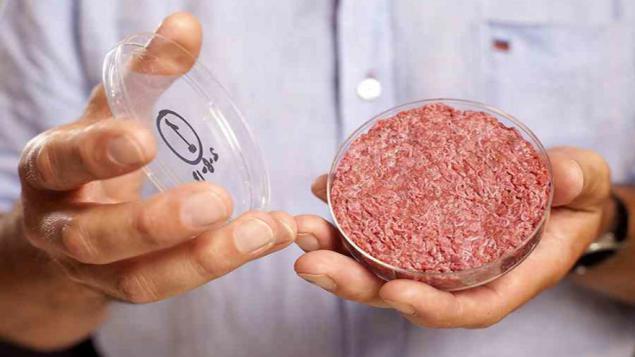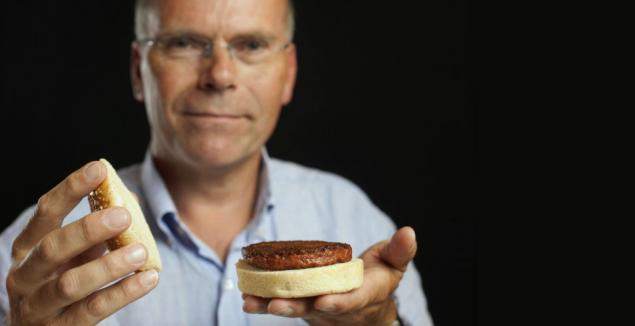Artificially grown meat in the lab will be available in the next 5 years
 Bashny.Net
Bashny.Net

The first prototype h3>
Proffesoru Marc Poust University of the Netherlands Maastricht, the world's first "hamburger in the laboratory," expects cultured meat will be on sale within five years.
The first prototype was prepared and eaten in London in 2013 for £ 215 000 (€ 292, 000; ₽2, 055, 000) for 1 burger
Currently, the price of meat has dropped to an incredible £ 7 ($ 11; ₽700)
This means that in two years managed to reduce the price of 31 000 times!
An alternative to animal meat h3>
"I am incredibly excited about the prospect of artificially grown meat on the market, I am sure that when this happens, many will be willing to go to our alternative meat product for ethical reasons," said Peter Verstrate «I am confident that our product will appear on the the market for five years. »
Daylight cultured meat will have an impact not only on the ethical issue, but it will also have a profound effect on many other aspects, ranging from ecology to solve the problem of hunger in the modern society, which will be written below.

Professor Mark Poust (Mark Post) - the creator of the world's first "artificial" burger in 2013 at a cost of £ 215, 000 i>
The first prototype was created in 2013 from stem cells taken from cows that were then "grown" in the 20, 000 thin strips of muscle tissue. After this tissue were laid out together, thereby forming a piece of meat for the burger. Despite the fact that the taste was very similar to meat, it still was not the same school, so had not yet done a little work, to improve the taste.
"Burger consisted only of protein and muscle fibers. But the animal meat - it's more than that. Meat - it is also fat and connective tissue, which determine the taste and texture of natural meat - but we did not, at the time. "
Now, in addition to the muscle fibers Pousta cultured in the laboratory, as well, and adipose tissue. To create this process took a long time, because until recently, it was not so much scientific interest in the cultivation of fatty tissue, and the methods of growing fat tissue used by chemists, are not suitable for this - "The original methodology of creation of fatty tissue Stem cells require steroids, which are not welcome in the food industry "- said Mark Poust," We had to redesign the method of working with cell biochemistry to find out what incentives we should use. Now we have a lot of natural components of fat that actually stimulate the production of fat tissue ».
Who cultivates laboratory Pousta beef fat and muscle tissue separately and then mix together. In the future, Poust, plans to create these two types of tissue as a whole, but at the moment, they are working to improve other factors farmed meat.
First Poust, plans to completely eliminate the use of animals in the process of cultivation. (stem cells that, for the moment, taken from cows, as well as fetal bovine serum is extracted from unborn calves) and go to the photosynthetic algae or cyanobacteria, for creating 100% but free from the use of animal products over which, in the the next 5 years and will be carried out the work.
Another technical issue that the team is trying to understand Pousta is how to increase the iron content in the cultured beef. In muscle tissue iron is mainly inside the oxygen-binding protein known as myoglobin. But due to the fact that there is no laboratory-grown meat circulatory system, it is stored in a medium with a high oxygen content, which affects the decrease in the expression of cell myoglobin. A less myoglobin in the meat, the less iron and the less nutritious meat
After culturing is beef, 2.0 - Having more fat, more iron, and, in the process of creation of which will be completely eliminated the role of animals, Poust start thinking about expanding production and output sale.
The transition from the Petri dishes to plants raises a whole new set of problems. Unfortunately, the process of improvement has not been disclosed, but Poust hinted that will be used in the creation of 3D printers
Video creation process h3>
What scientists are working on artificial meat h3>
Future menu farmed meat is not only beef burgers - several groups around the world are trying to clone the chicken breasts and fish fillets.
But why all the same scientists want to grow meat in a laboratory? The answer is simple - it will help to solve some important problems of mankind
The imprint on the environment, from the consumption of meat humanity, is 18% of the total air pollution. Produced animals methane, and N 2 sub> O, contributing to the "global warming", about 300 times greater than that of CO 2 sub>
In addition, animal husbandry occupies a large part of the arable land, drinking water, food and fuel resources of fossil fuels.

According to a study published in the US journal American Journal of Clinical Nutrition, livestock in the US consume seven times more grain than the American population, and grains, which would be enough to feed about 840 million people.
In addition, the lab meat is completely getting rid of parasites and diseases that occur in the animal meat. And, as well, will reduce our dependence on antibiotics in animal husbandry, which, in turn, slow the spread of antibiotic-resistant bacteria that also have a positive impact on health care for future generations.
That's all,
Share your opinion on this topic in the comments. Switched would you cultured meat in a laboratory, where it will be available?
Yes, go, I want to be one of those who will participate in solving the problems described above by clicking on artificial meat No, it will not pass (the reason can specify in the comments) I am a vegetarian, and I will have farmed meat, because animals suffer from it will not I am a vegetarian, and I do not start there, even farmed meat ¯ \ (ツ) / ¯ crossed, only if will not yield on the properties and the price of normal meat Voted 669 people. 60 people abstained. Only registered users can participate in the survey. Sign , please. Source: geektimes.ru/post/264100/
Tags
See also
The turbine, producing energy in irrigation canals
Private Russian company proposes to build a lunar base for 10 years
The most interesting features of smartphones that we expect in the next five years
Filet of beef artificial fell significantly
Artificial intelligence: extinction or immortality?
In the United States will soon begin testing a mobile artificial kidney + video
Scary story of the leak of the virus from laboratories
Very beautiful Soviet actresses
The habitable underwater laboratory Aquarius



















